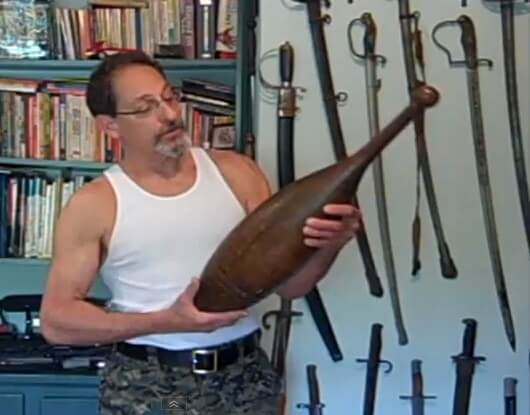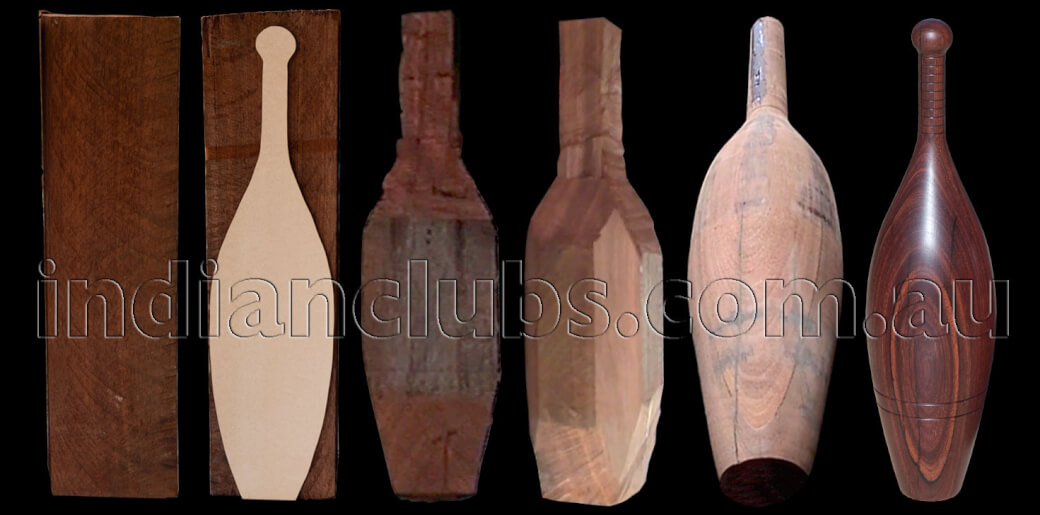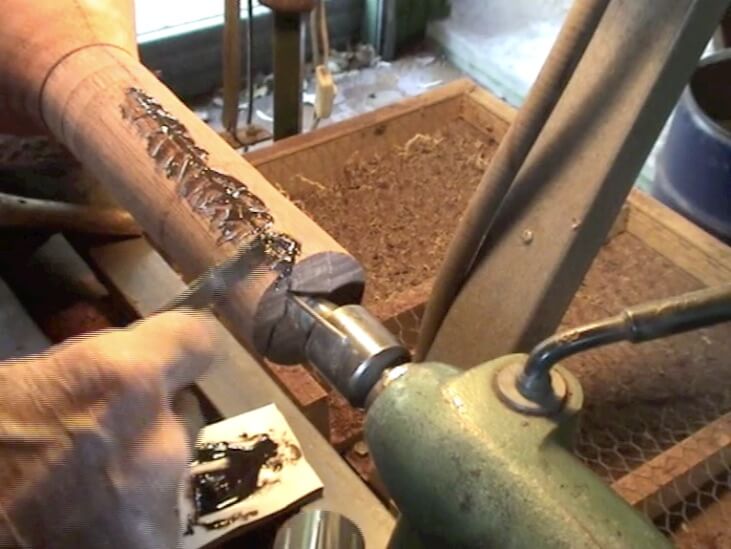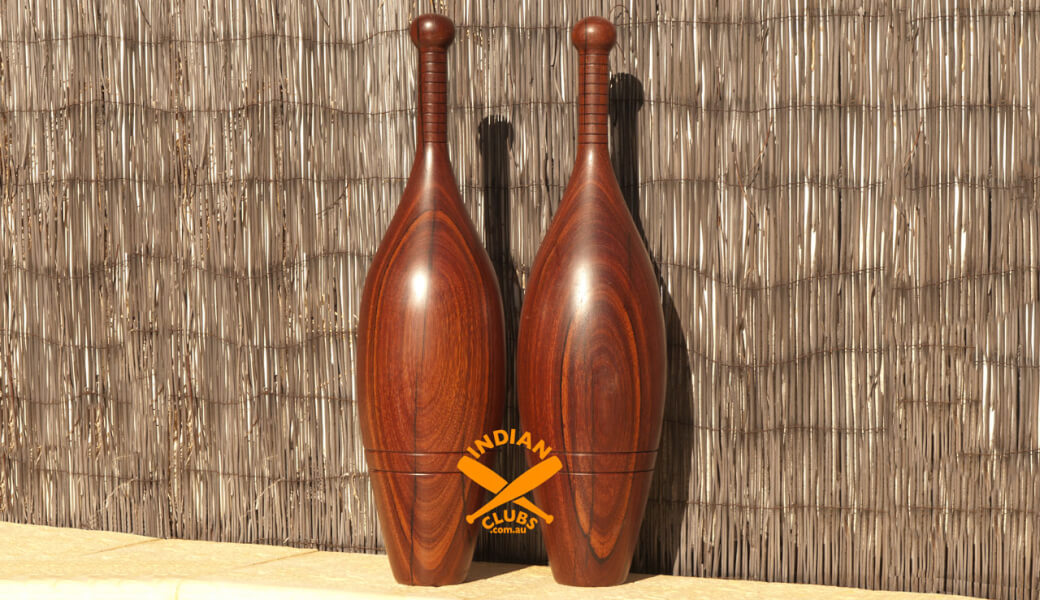Sim D Kehoe Replica Indian Clubs
In 1861, Sim. D. Kehoe, an American fitness enthusiast and businessman travelled to England where he observed the art of Indian Club Swinging. Believing he had found the perfect exercise apparatus, he began to manufacture and sell clubs to the American public in 1862.
Indian Club Exercise
Kehoe wrote a book called Indian Club Exercise which was published in 1866 to promote his companies athletic equipment. A few years ago Izzy Barish presented a YouTube video featuring an original Kehoe Club from his enviable collection of Indian Clubs.
The club shape was very different to anything I had seen or used, the body of the club flared out dramatically from the handle, and then elegantly disappeared into a narrow base, the silhouette reminiscent of a bowling pin or a fine bottle of vintage champagne.
The weight of this vintage club is 12lbs which is heavy in Indian Club terms, in the following years club profiles and sizes changed dramatically becoming lighter and sleeker, this development encouraging the popularity of Indian Club Swinging to the general public.
I decided to email Izzy Barish to ask him if he would mind providing me with measurements of his prized club enabling me to make replicas. Much to my delight Izzy kindly measured the club and emailed the details through.

Draft a Template
The next job was to draft a template of the club onto paper and produce a template that could be used by a woodturner to make the club. In a previous life I worked in the garment trade, so making a pattern of this type was straightforward.
During this development, I was also fortunate enough to meet up with Mike Simpson in England. Mike makes beautiful Indian Clubs and has written a handbook packed with information on club swinging.
My sincere thanks go to Izzy Barish for all his efforts in measuring the Kehoe club, to Mike Simpson for giving me some invaluable tips on making clubs, and to Joe Clark for his craftsmanship and woodturning skills.
Kehoe made One Piece Clubs
Finding the right sections of timber for the Sim D Kehoe Replica Indian Clubs, proved to be a challenge. Modern-day sawmills concentrate on the supply of market-driven demands for timber products, resulting in large sections of timber being hard to find. I wanted to make a pair of the replica clubs each out of one section of timber. This is the way I imagined Kehoe would have made his clubs.
After considerable searching I found a sawmill in Fremantle that had what I was looking for, they had a stack of sections cut from a local wood called Jarrah and measured 760mm x 200mm x 200mm. They were excess stock prepared for use as footings in a vineyard property built five years ago and had been warehoused since then, which meant that they were completely dry.

From left to right, the wooden blanks with template overlay through to finished club.
Drafting the Templates for Turning
In drafting the patterns for these clubs, I had created two smaller sizes that will be made up at a later date, on overlaying the template on the wood sections I found that there was room to make the clubs one size bigger by increasing the body of the clubs, this added about 20mm to the diameter, tapering off to the base and handle.
West Australian Jarrah, (Eucalyptus Marginata)
The magnificent Jarrah trees can grow up to 50 metres tall and is endemic to the southwest region of Western Australia.
Eucalyptus marginata, commonly known as Jarrah, Djarraly in Noongar language and historically as Swan River Mahogany, is a plant in the myrtle family,
Myrtaceae and is endemic to the southwest of Western Australia. It is a tree with rough, fibrous bark, leaves with a distinct midvein, white flowers and relatively large, more or less spherical fruit. Its hard, dense timber is insect resistant although the tree is susceptible to dieback. The timber has been utilised for cabinet-making, flooring, railway sleepers and Indian Clubs.
Jarrah belongs to the gum tree family and can have seams of gum running through it, making it unsuitable for turning clubs. The sawmill had a stack of about forty sections, I proceeded to look and found two seamless sections perfect for making clubs. On returning home I weighed both sections, they both came in at a hefty 23kgs.
Turning Waste
Logic dictates that there would be a weight loss due to the shaping and turning of these clubs, with the starting weight of 23kgs the question arose in guessing what the final weight would be. My estimate was 10kgs which was way out, the clubs weighed in at 7kgs each, a total weight loss of 16kgs. You can see how we tackled removing the bulk excess on the video………
Now things got really exciting, the replica Kehoe Indian Clubs were about to be made from a design created 150 years ago.
Joe Clark – Woodturner
With the timber and patterns ready, I paid a visit to Joe Clark who has made all my clubs so far. Joe mapped out the plan of attack. First, we would cut off the excess wood with a chain saw, reducing the bulk around the handle and the base of the clubs. Then each section would be mounted in the lathe and turned to produce a club.
From the day I first picked up a wooden club I remember the natural feel of the handle in my hand, and now standing in the workshop watching Joe turn the first club from a rough piece of wood was amazing. He held a chisel to the turning section and slowly the roughness started disappearing to reveal beautiful wood grains, as time went on the body of the club started appearing, tapering off to the base and handle.
Problems with Turning Jarrah
Suddenly Joe stopped the lathe and beckoned me over, the wood on the handle had split on the lathe. According to Joe, this is a common problem with Jarrah, as the tree grows older it gains in its circumference, the new outer growth pressurises the older inner core as it grows around it, there is no room to move and the ever-expanding inner core is caught in a time warp, in the current situation as we gradually removed the outer layers, pressure is released and the inner core splits. This problem is prevalent in woods belonging to the gum family.

Master Craftsman
Joe is a master craftsman, he mixed up some epoxy glue and started to fill the split. This turned out to be a labour of love as endless amounts of epoxy are fed in. We left the club for an overnight rest mounted in the lathe with a piece of masking tape covering the split, stopping glue seepage. On our return the next day the epoxy had done its job and turning recommenced, the work continued until we had a second split, out came the epoxy again and running repairs were done the same as before.
With the shaping work finished and in keeping with the original design, we cut two decorative rings into the body of the club and ten rings into the handle below the button, providing extra grip.

Sanding and Finishing
Then with the club still mounted in the lathe, the sanding commenced removing burrs and smoothing the finished surface. At this point, the wood grain started to show its natural beauty. To finish the clubs were sealed with varnish highlighting the grain even more.
Bathroom scales determined the club weight as 7kgs each, which was way below my estimate of 10kgs. I picked up the pair of clubs just to feel the weight and the first impression was heavy and I in a way I was relieved that the weight was 7kgs.
Challenge
On standing back to admire the clubs, their bulbous shape seemed almost threatening. Sim D. Kehoe Replica Indian Clubs, I knew instinctively that these beauties were going to provide a major challenge in swinging and handling.


Hi Audrey, Please keep me posted, I’d love to see your presentation. All the best. Paul
Hi, Paul!
Man, I find this story fascinating and the next thing that I want to do is carve a pair of Sim Kehoe clubs for myself.
I’ve been living in Rio de Janeiro for the last 9 years and, as such, certain things that are taken for granted in my former hometown of NYC are virtually impossible to find down here…things such as “handicraft wood-working drill bits” and such. It’s also been impossible to find a wood-turner in this town….it seems like this is a soon-to-be-lost art around these parts!
Therefore, inspired by the example of Andrew Vogelsang, whom you’ve featured on your site (I’ve subsequently found his blog also!), myself and my friend, Julio, have taken to carve our own clubs, using only hand-tools. (You recently viewed my first pair, which I re-posted on Facebook….)
I’ll soon be investing in a rotary electric hand-saw, as well as a plane and electric sander, in order to facilitate this work!
But, right now, I’m literally enthralled by the beauty of the Sim Kehoe design! And, one thing that is definitely in abundance over here in Brazil is beautiful hardwood! For these next clubs, I’m choosing either some fine Maçaranduba or Jacarandá wood!
Now, would you be so kind as to share the dimensions of the traditional Sim Kehoe clubs with me? I’ll be carving these by hand, but I would still like to approximate the correct dimensions as related to the thick part of the body, the length of the neck, the angle and length of the bottom taper, the proportional width of the handle ball, etc.
Yes, I’ll be shooting a video of these first hand-made clubs pretty soon….and, you’ll probably be the first to see it! My friend and partner, Julio, has launched a Facebook page titled, “Indian Clubs Brasil” and he’s posted a few videos of himself swinging some of his first clubs…. in case you wish to view those.
Thank you for the instruction that you offer online, Paul. I’m looking forward to meeting and training with you sometime soon!
Cheers!
Hi Frank,
Thank you for your kind words, I’ll have to do a bit of digging for you as it is a while since I use the Sim D Kehoe patterns, so bear with me. I will send them over when I find them.
I am really looking forward to seeing your videos and all the new clubs that you produce.
All the best
Paul
Hi, Paul!
I just got back from the Rio de Janeiro Botanical Garden, which is walking-distance from my home. I was training Clubs with Julio there, after having done an hour of Tai Chi Chuan with him and another musician friend.
Wow, man… I’m really stoked about whittling a replica pair of the Sim Kehoe style of clubs! Thank you very much for your kind consideration and I wait patiently for these patterns and dimensions.
In the meantime, my practice with these Clubs has become a pleasant daily ritual! Over this coming weekend, I’m looking forward to constructing my own Gada Mace, which I plan to do using a volleyball and a 4.6 in. bamboo stick. Up until I viewed your video in which you compare your own hand-made cement and bamboo Gada with an iron Mace, I had been looking around for a metal one…..and, I found a few commercially-made ones, which were all somewhat expensive. The cost of having these shipped to Brazil was literally quite exorbitant! But, I believe in what you say about the light weight of the bamboo handle being conducive to a better and faster pendulum swing, which should accrue better muscle and fitness development…..so this is definitely the way that I’m going to go right now!
Like I said before, when I improve considerably on these disciplines – which won’t be long from now – I’ll send you some video for your evaluation and help.
Thank you, and warm regards,
Frank